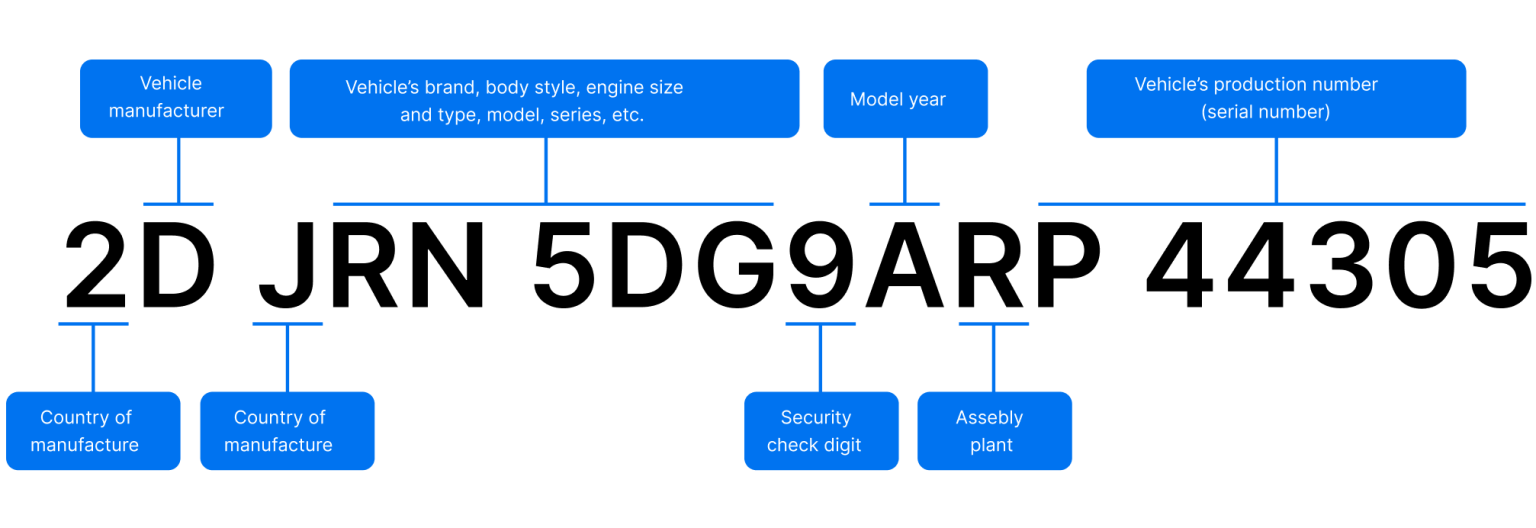A VIN Decoder is a tool that breaks down and analyses (“decodes”) Vehicle Identification Numbers (VINs).
The VIN is a 17-character number, which is the key to useful facts about the vehicle. This includes manufacturing information, specifications, features, and more. To learn this information, you need to know the meaning behind the VIN characters and their combinations. This can be complicated: the characters don’t mean the same thing for different manufacturers, models, and countries.
This is why our free VIN Decoder is useful: to learn some basic facts about any vehicle or VIN code, you only have to enter it into the field above and click Decode VIN.
A Vehicle Identification Number (VIN) number is a unique code identifying (almost) every vehicle in the world. Car manufacturers started using it in the middle of the 20th century, but without strict standards all manufacturers constructed their own VINs – different lengths, meanings, etc.
The current standard was issued in 1981. It requires VINs to be 17-characters long and without the letters O (o), I (i), and Q (q) to avoid confusion with similar-looking numbers – 0, 1, and 9.
More importantly, you can use the VIN to access records on global databases. These are very useful when buying a used vehicle – they’ll help you avoid scams like mileage rollbacks, hidden damages, and more.

As the VIN number is necessary to save various records and perform a VIN lookup, you have to know where to find it. The VIN code is always located in secure locations on the vehicle, so no one can accidentally damage or remove it.
Here are the most common VIN number locations:
These are the on-car locations, but you can also find it on the vehicle title documents (registration) and on the insurance certificate. Just remember that all VINs must match.
The Auto Inspectra VIN checker scans dealer, repair shop databases, car sales reports, rental companies worldwide and provides you with all kinds of information from regular mileage checks to photos of damages.
While a free VIN decoder provides only basic data, here’s what you may learn about from a full Auto Inspectra vehicle history report:
Don’t risk your own safety when buying a used car – put its VIN code in our VIN decoder and unveil potential safety issues and problems right away.
If you’re familiar with car history reports and free VIN decoders, you probably already know the difference in the amount of information they provide. The reason for this is simple – most information isn’t free.
A free VIN checker mostly provides data that’s accessible for free. We can always tell you the car’s make, model, and year of manufacture. In some cases, we can access even more data: e.g.: for some cars, we can give you the basic vehicle specifications. Technically, you could scavenge the internet for all of that information, but an actual VIN searcher does that in a matter of seconds, saving lots of your time.
The information our free VIN Decoder can find varies from one vehicle to another.
When it comes to the full vehicle history report, we delve into various paid databases around the world. Auto Inspectra has built strong business relations with auctions, insurance companies, manufacturers, and other institutions to obtain as much valuable and reliable data as possible.
Not only is this data not free – a regular individual won’t always be able to simply buy it.

The VIN number consists of 17 characters, which are divided into multiple sections. And you can technically decode a VIN without using a decoder. Every character has a fixed meaning.
The first section, known as the WMI code, has three characters.
The structure of the World Manufacturer Identifier section is a bit different when the vehicle isn’t mass-produced.
The second section is the Vehicle Descriptor Section (VDS), and it consists of five characters. They hold information about the engine size and type, braking system, car series, model and body style. Each character represents different features and their meaning depends on the manufacturer.
The last 9 characters are the Vehicle Identifier Section or VIS. The information in this section is different, depending on whether the maker is American, European, or Asian.
There’s no doubt that many vehicles will have the same configuration and will be assembled in the same location, so the only difference in their VIN is going to be the serial number.
Figuring out the model year without a chart is complicated. For example, while “1” is 2001 and “2” is 2002, “A” is 2010, and “B” is 2011.
Each assembly plant also has its own coding, so it’s best to find the character first and then look it up.
This is the shortest section, and it has only one character – a “check digit.” This digit is the result of a mathematical operation, using all the other VIN characters into a formula.
If at least one character is fake or incorrect, the result won’t match the check digit. It’s possible to calculate the check digit yourself without performing a VIN search.
Our universal VIN Decoder doesn’t work with old VIN formats due to different formatting. Vehicles manufactured between 1954 and 1981 use various VIN formats, so you’ll have to find a specific VIN lookup tool to decode them.
With that said, pre-1981 models can also be stolen, damaged, or written off just like any vehicle. As such, old VIN numbers are still necessary.
VIN numbers aren’t as common in Japan. Instead, the country often uses chassis or frame numbers, whose format is completely different from the standard 17-character code.
Ordinary decoders can’t recognise these “chassis numbers” and “frame numbers” found in Japanese vehicles, so you’ll have to look for a decoder designed specifically for them.
Most countries require you to register a vehicle to use it on public roads. This means there are databases holding data about each vehicle based on license plate numbers. Often license plate checks are free, but this depends solely on the country.
This check should provide no more than basic information like vehicle make and model, title and insurance status. Additionally, it’s not nearly as useful in cross-border situations
There are many reasons why it is important to do a VIN lookup. They depend on the situation of the user.
You may want to get a free VIN Decoder check to:
Getting a VIN lookup for a full vehicle history is important if you’re:
A VIN decoder processes Vehicle Identification Numbers (VINs), analyzes them, and helps users learn the meaning behind the 17-digit VIN code.
A free VIN decoder provides only information that is freely available. This includes details about the model and (sometimes) basic specifications, but typically does not include vehicle history data.
A paid VIN check shows important historical information about a vehicle. This includes past damages, suspected mileage rollbacks, and more.